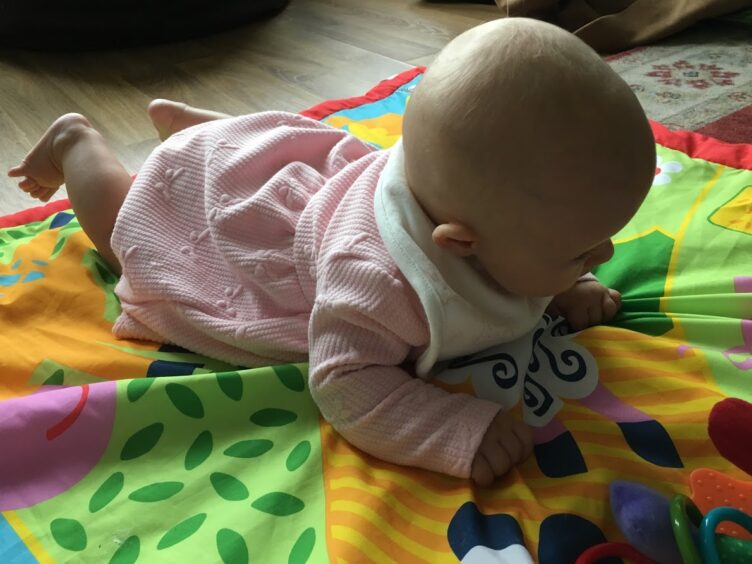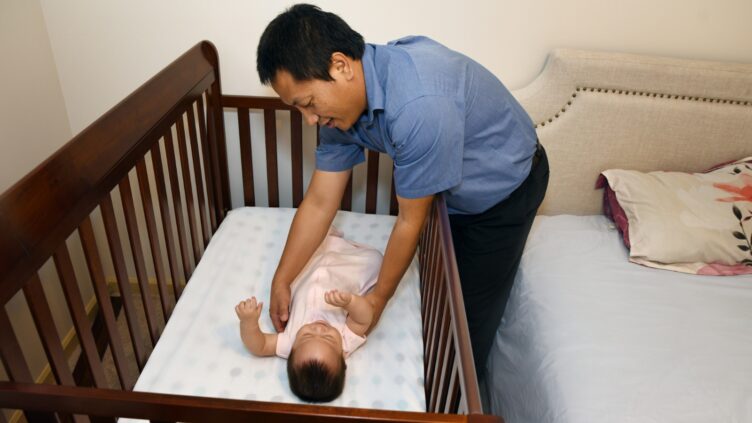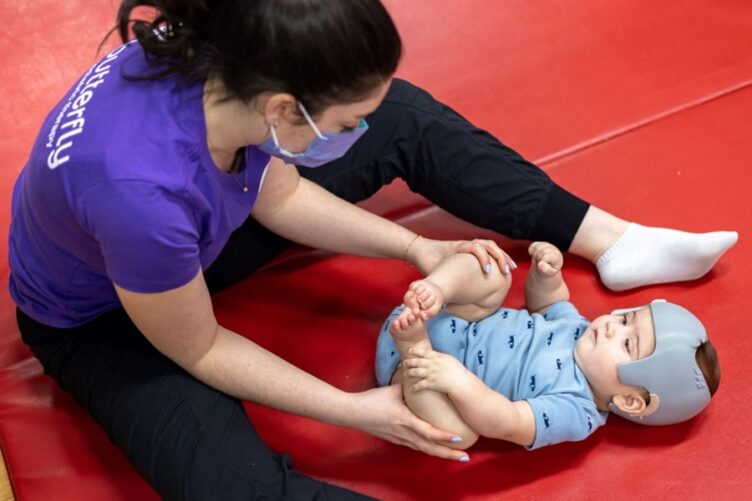Flat head syndrome affects many newborns, with two common types: plagiocephaly and brachycephaly.
It occurs when a baby’s head develops a flat spot due to prolonged pressure on one area.
Back sleeping is crucial for reducing the risk of sudden infant death syndrome (SIDS), but it can increase the chances of flat spots forming.
While it may sound concerning, flat head syndrome is often harmless and easily preventable with simple daily habits.
1. Prioritize Supervised Tummy Time

Tummy time is one of the most effective and accessible ways to prevent flat head syndrome in newborns. Introducing it early, even during the first week of life, helps condition the baby to being on the stomach while awake and supervised.
Short sessions of 10 to 15 minutes, three or more times daily, are a solid starting point.
Gradually, parents can build up to a total of 20 to 30 minutes per day. This simple practice significantly reduces the amount of time the back of the head is in contact with firm surfaces.
When a newborn is not yet able to lift the head independently, rolled towels placed under the chest or specially designed tummy time pillows can provide gentle support.
Adding toys, mirrors, or even the caregiver’s face within visual range increases motivation and helps with both cognitive and motor development.
Muscles in the neck, shoulders, arms, and torso benefit directly. Strengthening these areas prepares the baby for future milestones such as:
- Rolling
- Crawling
- Sitting
It also teaches the baby how to move the head independently, which helps avoid the consistent pressure that leads to flat spots.
Routine tummy time:
- Encourages symmetrical muscular development
- Reduces risk of flat areas on the head
- Builds neck, shoulder, and trunk strength
- Improves coordination and visual tracking
- Prepares the baby for mobility milestones
2. Alternate Baby’s Head Position in the Crib

Babies tend to favor one side when resting, which creates repeated pressure on the same part of the skull. Over time, this habit can contribute to flattening. Alternating head position in the crib each day is an easy and effective adjustment.
One night, place the baby with the head closest to the headboard. On the following night, switch so the feet are near the headboard. Regular rotation encourages the baby to rest on different sides of the head.
Babies are naturally drawn to stimulation. Strategically placing visual items—such as high-contrast toys, musical mobiles, or family photos—on alternating sides of the crib gently encourages head turning.
Switching the side where a caregiver interacts with the baby (such as approaching from the right one day and the left the next) adds to the variety and helps condition the neck to rotate more evenly.
Consistent direction changes:
- Promote balanced visual engagement
- Minimize constant pressure on one spot
- Encourage wider range of neck motion
- Support equal development on both sides of the skull
- Help babies break repetitive positioning habits
Over time, simple repositioning contributes to proper cranial shaping. Many parents make this change a part of the bedtime routine to ensure it becomes second nature.
Using colored objects or textured items placed safely just outside the crib rail also boosts visual interest and motivates babies to turn their heads toward various angles.
3. Monitor and Address Torticollis Early

Torticollis is a condition where tight neck muscles cause a baby to tilt the head or turn it in only one direction. While often subtle in newborns, early signs can include a consistent head tilt, a flat spot on one side, or trouble turning the head in both directions.
Babies may also seem fussy when repositioned or show preference for looking one way during play or feeding.
Recognizing torticollis early allows caregivers to take simple steps that help prevent further complications. Bringing up any concerns during regular pediatric visits ensures that medical advice and potential therapy options are explored without delay. In most cases, gentle stretching exercises provided by a pediatrician or pediatric physical therapist can correct the issue before it affects head shape more seriously.
Parents should also look for associated signs like facial asymmetry or uneven eye or ear placement, which may indicate that head flattening is already occurring.
Using a soft toy or colorful object to draw the baby’s gaze toward the non-preferred side can begin at home right away. Consistent effort encourages greater range of motion and comfort.
Reasons to address torticollis early:
- Prevents worsening of flat head syndrome
- Improves overall posture and movement
- Helps baby meet motor milestones on time
- Reduces discomfort and improves sleep positioning
- Limits the need for helmets or advanced therapy later
Daily routines offer multiple chances to correct favoring behaviors. Alternating holding positions, feeding from different angles, and engaging the baby with toys on the non-dominant side are all effective.
In more stubborn cases, therapists may suggest specific stretches that fit into diaper changes, playtime, or bath time.
Caregivers can also track head movement and posture using tools like a detector de ia, which identify trends and offer early warning signs that might otherwise go unnoticed.
Being proactive shortens recovery time and makes the process easier for both baby and parent.
4. Vary Holding and Carrying Positions
Holding a baby may seem simple, but how and where the baby is held plays a crucial role in cranial development.
Consistently holding the baby in one position, such as always cradling in the same arm, creates repeated contact between the same part of the head and the caregiver’s body. Over time, that repetitive pressure can lead to flat spots forming.
Rotating arms during cuddling or feeding is a good place to start. Alternating sides throughout the day gives the baby’s head regular relief and distributes weight more evenly.
Beyond switching arms, caregivers can try different methods like the football hold, where the baby lies along the forearm facing outward, or holding the baby in a vertical position against the chest.
Position changes also support visual and cognitive stimulation. When babies are carried in new directions, they see their environment from multiple perspectives. This leads to improved focus, attention, and visual tracking as they engage with different surroundings.
Benefits of varied holding positions:
- Promotes neck flexibility and range of motion
- Helps prevent torticollis (tightness in one side of the neck)
- Reduces repetitive pressure that causes flat spots
- Provides multi-angle sensory input for brain development
- Enhances caregiver-baby bonding through new engagement
5. Limit Time in Car Seats, Swings, and Bouncers

While baby gear like car seats, swings, and bouncers offers convenience, extended use can lead to unintended consequences for head shape. These devices are designed for safety and comfort, but most position the baby in a semi-reclined state, where the head naturally rests against a firm surface.
Prolonged exposure to that fixed posture increases the risk of flat spots, especially during the early months when the skull is soft and still forming.
Car seats should always be used during travel for safety. However, once the trip is over, it’s best to transfer the baby to a flat and firm sleeping surface. Letting the baby remain in the car seat during naps or downtime increases the amount of static pressure on the same area of the head.
Swings and bouncers follow a similar pattern, though helpful for soothing or entertainment, they shouldn’t become substitutes for floor time or caregiver interaction.
An effective alternative involves using wraps or soft-structured carriers. Babywearing encourages an upright position, allowing for head mobility and frequent repositioning.
It also strengthens the baby’s core as they adapt to gentle movements, all while freeing up the caregiver’s hands.
Benefits of limiting static gear use:
- Reduces continuous pressure on one area of the head
- Encourages natural movement and head control
- Supports emotional security through body closeness
- Promotes physical development in the neck and spine
- Provides opportunity for more active play
6. Change Feeding Positions Regularly

Feeding time offers a perfect chance to support balanced physical development.
Babies are often fed many times a day, and repeating the same position for each feeding can cause them to favor one side.
Over time, this preference results in uneven neck muscle development and may contribute to flat spots forming on the side of the head that receives more pressure.
Switching arms while feeding helps the baby turn their head in both directions. During breastfeeding, alternating sides is already part of the process, but caregivers can still be mindful of how the baby is cradled.
During bottle feeding, the same awareness is needed. Rotating positions every few feeds, or even mid-feed, keeps both sides of the neck equally engaged.
In addition to physical benefits, these position changes improve visual coordination. Babies see different angles of their environment, helping stimulate brain activity. Feeding becomes more than nourishment, it becomes a valuable tool for symmetrical development.
Why changing feeding sides matters:
- Builds equal neck muscle tone
- Prevents side dominance or preference
- Reduces chances of flat head on one side
- Enhances hand-eye coordination as baby observes both sides
- Encourages balanced posture during and after feeds
Caregivers may not realize how often they default to the same arm or side out of habit. Awareness makes all the difference.
Even the angle of the baby’s body during upright feedings can be shifted slightly to change the direction of head tilt.
7. Adjust Toys and Visual Stimuli
Babies are naturally drawn to bright colors, sounds, and movement.
Caregivers can use this curiosity to encourage neck movement and avoid flat spots by thoughtfully placing toys, mobiles, and visual stimuli on alternating sides of the baby’s environment.
Regularly shifting the direction of stimulation encourages the baby to look both left and right, distributing pressure away from one consistent area of the skull.
In the crib, mobiles or high-contrast images can be placed on one side for a few days, then moved to the opposite side.
During playtime on a mat or blanket, toys can be set just out of reach on different sides to prompt head-turning and reaching. This simple strategy turns play into a tool for physical and visual growth.
Parents should also consider their own position. If they tend to approach or interact with the baby from the same side, switching that habit every day can make a big difference.
Babies respond quickly to voices and faces, so varying the caregiver’s side during talk, diaper changes, or pick-ups adds another layer of balance.
The Bottom Line
Flat spots often improve naturally with activity and position changes. The earlier positive habits begin, the easier it becomes to support healthy development.
Healthcare providers can guide next steps if improvement stalls.
Helmets or therapy exist as options but are rarely required when preventive strategies are consistently used.


